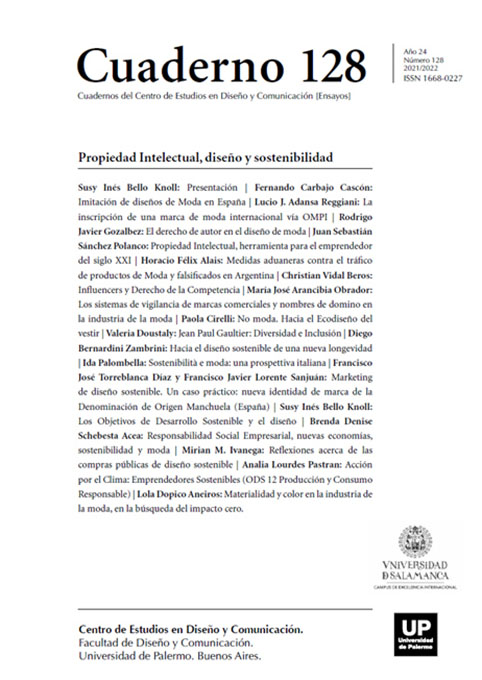Materialidad y color en la industria de la moda, en la búsqueda del impacto cero
Abstract
In this article we aim to review various case studies through which we can locate the main strategies that are central to fashion design proposals in terms of dyeing and printing treatment and which, in a relatively short period of time, have the mission of achieving a radical transformation of the fashion industry. In the first instance, we have tried to identify a series of innovations that are already a reality, to a greater or lesser degree of development and achievement, but which will lead to a substantial change towards more efficient design. For this approach, we have grouped them largely according to one of the following typologies, or a combination of them, and which could be organised on the basis of the following strategies: the use of dyes from food waste, the increase in the use of raw fabrics or especially the reuse of fibres and/or fabrics by upcycling process, the expansion of the supply of natural dyes, and the development of biotechnology applied to the creation of colours.
References
Asociación española de químicos y coloristas textiles (20 de diciembre de 2017). Archcroma color partners. Recuperado de: https://aeqct.org/email/preview/NjI/505-a958e907282d4da2a65d/
Brones, A. (14 de noviembre de 2016). Coffee Waste or Product Potential? Fresh Cup Magazine. Recuperado de: https://www.freshcup.com/coffee-waste-or-product-potential/
Cole, J. (2019). El teñido de tejidos: el mayor problema de contaminación de la industria de la moda. Vogue. Recuperado de: https://www.vogue.es/moda/articulos/tintes-toxicosropa-problemas-contaminacion-industria-moda
Coppard, A.(2010). GSK Contemporary _ Aware: Art Fashion Identity. Royal Academy of Arts London.
Chieza,N.; Ginsberg, A. D.; Lee, S., Agapakis, C. & Vilutis, J. (1 de febrero de 2019). Design with science. Other Biological Futures. Journal of Design and Science. NY
Domínguez Siemems, A. (2019) Entrevista a Lidewij Edelkoort, la gurú de las tendencias de moda y diseño. Arquitectura y Diseño. Recuperado de: https://www.arquitecturaydisenoes/estilo-de-vida/entrevista-a-lidewij-edelkoort-guru-tendencias-moda-y-diseno_2861FAO (2014) Informe del Grupo de alto nivel de expertos en seguridad alimentaria y nutrición. Las pérdidas y el desperdicio de alimentos en el contexto de sistemas alimentarios sostenibles. Recuperado de: http://www.fao.org/3/a-i3901s.pdf
Fletcher, K. (2014 [2008]). Sustainable Fashion and Textiles: Design Journeys. London: Earthscan.
Fletcher, K. (2016). Craft of use: Post Growth Fashion. London: Routledge.
Fletcher, K. y Grose, L.(2012). Gestionar la sostenibilidad en la moda: Diseñar para cambiar materiales, procesos, distribución, consumo. Barcelona: Blume
Fletcher, K. and Tham, M. (Eds) (2019). Earth Logic Fashion Action Research Plan. London: The J J Charitable Trust.
Ginsberg, A. D. & Chiezan, N. (12 de septiembre de 2018). Editorial: Other Biological Futures. Journal of Design and Science. NY
Greenpeace (24 de febrero de 2013). Historial de la campaña de DETOX. Recuperado de: http://archivo-es.greenpeace.org/espana/es/Trabajamos-en/Parar-la-contaminacion/Agua/Campana-Detox-/Historial-Detox/ Gwilt, A. (2014). Moda Sostenible. Barcelona: Gustavo Gili.
Hernández Bonilla, J. M. (4 de septiembre de 2020). Las microfibras de tus “jeans” llegan hasta el Ártico. Diario elpaís.com. Recuperado de: https://elpais.com/ciencia/2020-09-04/las-microfibras-de-tus-jeans-llegan-hasta-el-artico.html
Kallis, G. (2017). Radical dematerialization and degrowth. Phil. Trans. R. Soc. A 375: 20160383. http://dx.doi.org/10.1098/rsta.2016.0383
Little, T. (2018). The Future of Fashion: Understanding Sustainability in the Fashion Industry. Washington: New Degree Press.
Lipps, A.; McQuaid, M.; Condell, C. & Bertrand, G. (2019). Nature: Collaborations in design. New York Cooper Hewitt: Smithsonian Design Museum.
Naciones Unidas (1987). Informe Brundtland. Recuperado de https://undocs.org/es/A/42/427
Naciones Unidas UNFCC (2015). Aprobación del Acuerdo de Paris. Recuperado de: https://unfccc.int/sites/default/files/spanish_paris_agreement.pdf
Noble, B. (2017). Fashion: The Thirsty Industry. Thread Harvest. Recuperado de: https://threadharvest.com.au/blogs/news/fashion-the-thirsty-industry
Rosen, E. (7 de enero de 2021). Fashion trends are often recycled, Now more clothing can be, too. The New York Times. Recuperado de: https://www.nytimes.com/2021/01/26/fashion/sustainability-clothes-environment-technology.html?searchResultPosition=1
Saulquin, S.(2010). La muerte de la moda, el día después. Buenos Aires: Paidós The Ellen MacArthur Foundation (enero, 2013). Towards the Circular Economy: Economic and business rationale for an accelerated transition. Informe, 21-25. Recuperado de: https://www.ellenmacarthurfoundation.org/assets/downloads/publications/Ellen-MacArthur-Foundation-Towards-the-Circular-Economy-vol.1.pdf
The Fashion Pact (2019). Recuperado de https://thefashionpact.org/wp-content/uploads/2020/10/038906e111abca13dce4c77d419e4f21.pdf
The Global Change Award (2015). Recuperado de: https://globalchangeaward.com/
Los autores/as que publiquen en esta revista ceden los derechos de autor y de publicación a "Cuadernos del Centro de Estudios de Diseño y Comunicación", Aceptando el registro de su trabajo bajo una licencia de atribución de Creative Commons, que permite a terceros utilizar lo publicado siempre que de el crédito pertinente a los autores y a esta revista.


